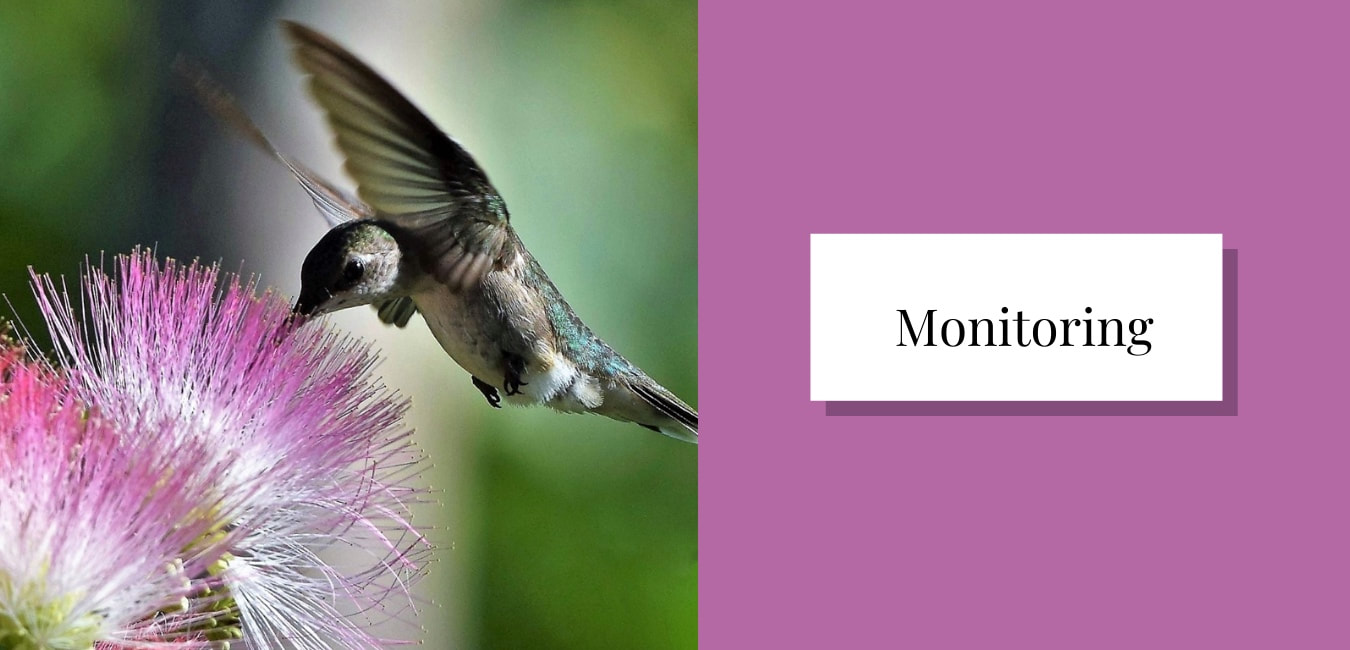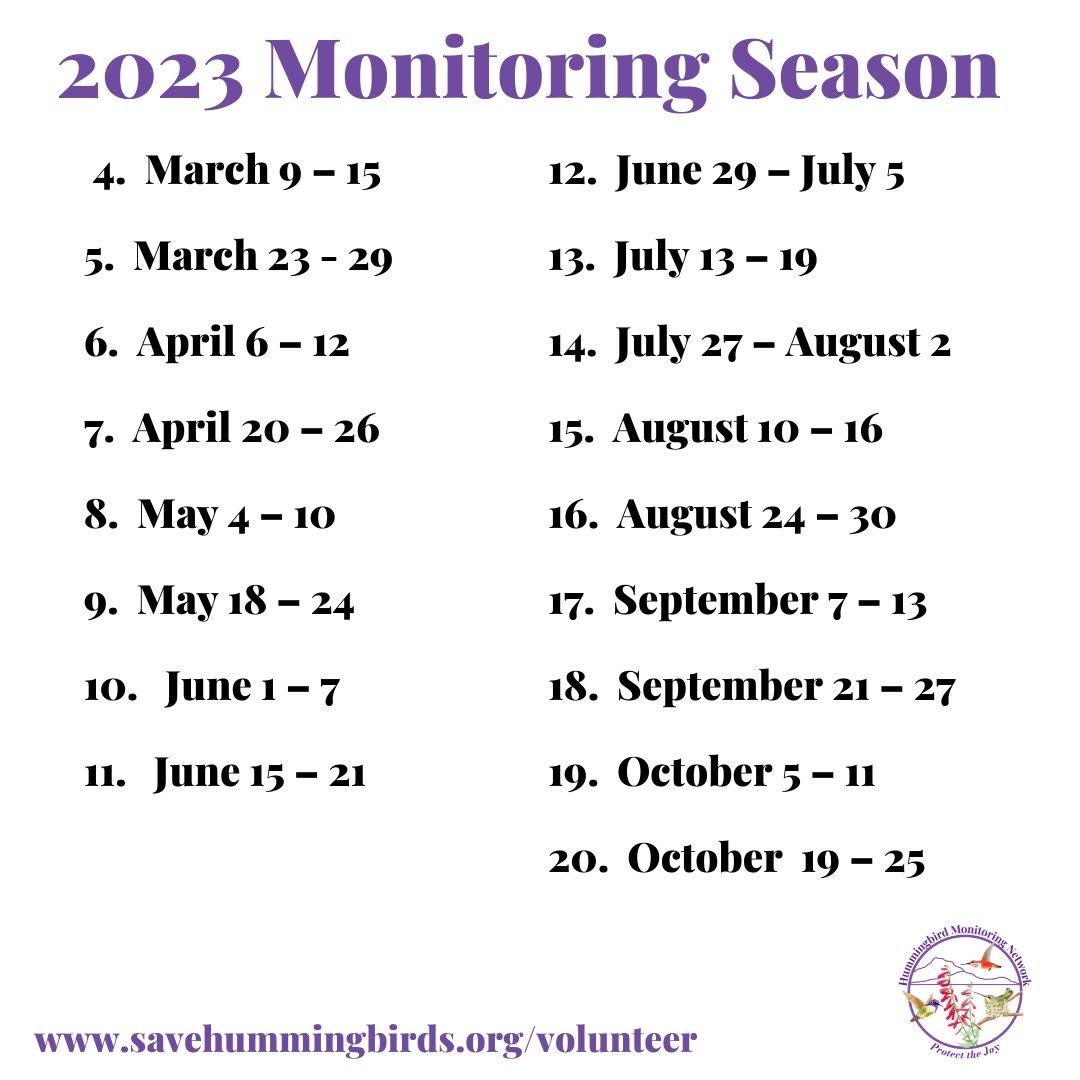Hummingbirds are unique birds for their exclusive physiology, their beauty, and their essential role as pollinators. They have inspired people for centuries, connecting us with nature.
To thrive, hummingbirds have specific habitat requirements, which, unfortunately nowadays, are at risk. Habitat loss and degradation as millions of acres of vegetation continue to be lost to agriculture, urbanization, and climate change are the primary threat for hummingbirds. These threats are causing significant impacts on their population sizes and their ability to survive.
For us, monitoring is listening and learning from hummingbirds. It is an essential tool to identify species at risk, assess population size changes, and determine how hummingbirds respond to environmental changes. Furthermore, monitoring provides the foundation for establishing conservation, restoration, and research actions and helps us understand how these efforts impact hummingbird populations.
To thrive, hummingbirds have specific habitat requirements, which, unfortunately nowadays, are at risk. Habitat loss and degradation as millions of acres of vegetation continue to be lost to agriculture, urbanization, and climate change are the primary threat for hummingbirds. These threats are causing significant impacts on their population sizes and their ability to survive.
For us, monitoring is listening and learning from hummingbirds. It is an essential tool to identify species at risk, assess population size changes, and determine how hummingbirds respond to environmental changes. Furthermore, monitoring provides the foundation for establishing conservation, restoration, and research actions and helps us understand how these efforts impact hummingbird populations.
Programs
TREND MONITORING
For 18 years, we have monitored hummingbird populations in western Canada, United States, and Mexico. Hummingbird Monitoring Network’s program initially began in 2002 with sites in California and Arizona and has expanded to nearly 30 active banding locations over time. We partner with federal and state agencies, nonprofit organizations, universities, and individuals who work as volunteers or citizen scientists.
Together, our purpose is to collect demographic data to determine population trends and raise awareness when tendencies suggest conservation issues affect a specie's ability to thrive. View both current and archived monitoring reports here and our Standard Protocol.
Our trend monitoring program goals are:
- Maintaining long-term monitoring sites that represent a region’s hummingbird diversity across each species range
- Collecting detailed demographic information on hummingbird populations so trends can be detected
- Training individuals interested in working with HMN and/or whose work would benefit from hummingbird banding
- Using the resulting information to recommend restoration and conservation actions
EFFECTIVENESS MONITORING
Monitoring efforts collect information needed to identify changes and trends in populations and evaluate conservation actions’ effectiveness. Effectiveness monitoring evaluates management actions on restoring populations and enhancing habitats. Specifically, monitoring information is needed that will enable land managers and community members to design, develop, and implement projects to strengthen hummingbird habitats. We listen to hummingbird responses to changing conditions using field techniques and long-term monitoring. Our purpose is to assess the availability and quality of resources and habitat conditions to ensure hummingbirds’ survival and ability to thrive.
Our effectiveness monitoring program goals are:
- Providing a better and broader understanding of hummingbird habitat use in communities’ landscapes
- Identifying hummingbirds' conservation needs in the territories of our HCCR’s
- Contributing information about hummingbird habitat to establish restoration activities for hummingbird conservation
- Quantifying and assessing hummingbird resource availability in the landscape
- Determining conditions for hummingbirds' survival and reproduction in the community’s landscape
SITE RELATIONSHIPS
HMN has many active monitoring sites. Each has specific characteristics and management guidelines: some are located on private property, many are on public land, and others are communal territories; therefore, the features, needs, and management actions of each are also distinctive. We work closely with the land managers of these territories to support their needs to maintain positive and long-term relationships allowing us to continue working together in these areas. Our purpose is to support each study site where trend and effectiveness monitoring programs occur, ensure and maintain long-term monitoring sites, and promote strong relationships with partners and landowners.
Our site relationship program goals are:
- Establishing good relationships and agreements with government agencies, communities, research stations, and landowners where monitoring is conducted
- Reaching agreements for the management of each monitoring site with partners
- Developing positive relationships with public and private land managers
- Providing monitoring results to land managers to help them determine the appropriate conservation of hummingbird populations within each monitoring site
WORKSHOPS
Providing educational opportunities to the community is crucial for HCNs’ aspiration to involve more people in hummingbird conservation initiatives and actions. Offering workshops in field study techniques and banding is the starting point for establishing, developing, and successfully achieving the goals of our monitoring program. Thus, HCNs plans to carry out numerous workshops over the next several years. Our workshops’ primary purpose is to train people in various field techniques to study and monitor hummingbird populations, evaluate their resources and habitats, and identify restoration and conservation needs. This is done while also promoting collaboration, critical thinking, and communication among participants.
Our workshops' program goals are:
- Instilling knowledge and helping to develop field research techniques, banding, and habitat evaluation for students, professionals, researchers, and community members
- Providing a workbook containing the most critical techniques for hummingbird studies and their environmental evaluation
- Offering participants the opportunity to practice learned techniques with the guidance of experts in the field
- Organizing periodic workshops to engage more people and motivate hummingbird research
- Promoting the use of standardized protocols for hummingbird studies




